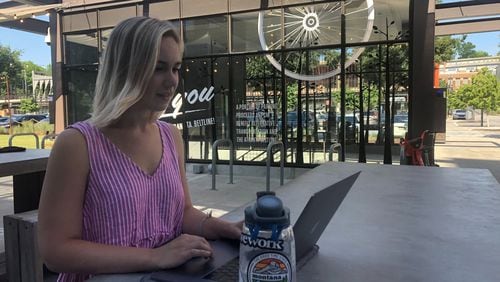Austavious Gholston often walks seven miles from his intown Atlanta neighborhood to Ponce City Market, strolling along tree-lined streets and through pocket parks before ending up on the Beltline.
The chance to enjoy the outdoors more was part of the reason he decided to move to Lake Claire from Gwinnett’s Hamilton Mill area six months ago.
“When I was in Gwinnett, it was pretty much a drive-everywhere culture,” said Gholston, who is 26 and works at a FedEx warehouse. “I wanted to be outside more, do more, walk more.”
It seems to Gholston that healthy changes are taking place not just for him, but Atlanta as a whole. Amenities like the Beltline encourage healthy habits, he said.
And, according to one study, he might be right. Atlanta placed 22nd in a new fitness ranking of the largest 100 U.S. cities. The analysis was recently released by the American College of Sports Medicine and the Anthem Foundation, the philanthropic arm of Anthem Inc., an Indianapolis-based health-care company.
The 2019 American Fitness Index examines and ranks cities on dozens of health factors like aerobic activity, smoking, obesity and fruit and vegetable consumption. The ranking is also based on community and environmental factors such as air quality, the number of parks, access to farmers markets and use of public transportation.
Using data from the Centers for Disease Control and Prevention, the U.S. Department of Health and Human Services, the U.S. Environmental Protection Agency and other agencies, the rankings offer a look into the healthiest — and unhealthiest — cities in the country.
Arlington, Va., claimed the title of “America’s Fittest City.” Residents of the northern Virginia city, across the Potomac River from Washington, D.C., reported the highest rates of physical activity in the previous month and low rates of smoking and pedestrian fatalities.
Oklahoma City came in last place.
"This ranking answers the question, if I want to live in a city and be physically fit, do the assets within the city support my needs to be fit?" said Georgia State University professor Walt Thompson, past president of the ACSM and a member of the Fitness Index Board.
To better assess that, changes were made to the ranking system, nixing some categories and adding others. Organizers of the survey believe the tweaks give residents to get a truer picture of a city’s strengths and weaknesses.
They’ve also changed the areas examined making it difficult to compare past results and current ones. Before, metro areas were ranked instead of individual cities, and the Atlanta region landed in the 20th spot in 2018. This year, the analysis added an air quality score and a score evaluating the planning and design of safe streets for walking, biking and driving.
Even though Atlanta was in the top quarter of all cities, there is a lot of room for improvement, said Thompson.
For example, about 13% of Atlanta residents smoke – that’s twice the percent of Arlington residents. For comparison, about 18% of Oklahoma City residents smoke. Meanwhile, New York City scored No. 1 for public transportation, with over half (56%) of residents using it to get to work.
In Atlanta, a city not known for having a robust public transportation system, only 11 percent of residents use public transportation to go to work. But that’s still far higher than Oklahoma City, where less than 1% of residents take public transportation to work.
Only a third of Atlanta residents eat two or more servings of fruits a day. In Madison, Wis., it’s about 47%. But in Oklahoma City, only about 23% of residents consume two or more servings of fruits a day.
There were also some grim findings in the report. Atlanta found itself on a separate ranking for the worst cities for pedestrian deaths. Atlanta is No. 5 on the “deadliest cities” list, with 4.1 pedestrian fatalities per 100,000 residents annually. The 10 safest cities, meanwhile, averaged 0.6% pedestrian fatalities per 100,000 residents every year.
With fewer drivers paying attention, pedestrian deaths in the U.S. reached the highest level in almost 30 years in 2018, according to a study by the Governors Highway Safety Association.
Thompson said it’s not easy to stem the tide of pedestrian deaths, but that it’s important for city officials to plan wider sidewalks and more bike paths whenever possible.
Thompson said the annual rankings can be a wake-up call for residents on a personal level, but also for city officials to address some of the shortcomings in their communities.
Thompson also sees bright spots in Atlanta that encourage healthy living, including PATH Foundation trails and the Beltline. And once the Beltline is completed, it will connect 45 intown neighborhoods with multi-use trails and parks.
Thompson also believes the city should add more farmers markets. Atlanta is surrounded by farmland but has far fewer than many cities, he said, with about 23 farmers markets per 1 million residents. In Washington, D.C., there are 82 farmers markets per 1 million residents.
Kristen Smith, a registered dietitian for Piedmont Hospital, said it’s always good to add more farmers markets, especially in neighborhoods with few grocery store options. But she’s thrilled about a food forest program in southeast Atlanta, which, with federal grants and additional support from non-profit groups Trees Atlanta and The Conservation Fund, allows city residents to pick up fresh fruit free of charge.
Dr. Jonathan Kim, chief of sports cardiology at Emory University, said Atlanta has some inherent challenges for supporting healthy lifestyles. A lack of public transportation infrastructure and a heavy dependence on cars pose impediments to a healthy lifestyle, he said.
And there are pockets of the city that aren’t pedestrian friendly, he said.
“If I am in midtown or at the Beltline and everyone is out and about walking, it reminds me of Boston or New York,” said Kim. “But, if you are talking about downtown Atlanta, forget about it — unless you are walking around Centennial Park.”
Residents Georgia, and other southern states, continue to be plagued by low levels of physical activity, high rates of smoking, and obesity rates higher than the rest of the country.
But Kim, who is also head team cardiologist for the Atlanta Falcons, Atlanta Hawks and Atlanta Braves, also sees some reasons for optimism.
He’s encouraged by plans for transit expansion in Atlanta, which will include billions of dollars’ worth of transit construction in coming decades. Less expensive, locally funded projects — such as bus rapid transit lines — would come first. More expensive projects — including 29 miles of light-rail lines — could come later, dependent on federal funding.
“There is a large proportion of people who are very excited about living healthy in our city, and there is a voice trying to change some of the trends of inactivity and unhealthier habits,” he said.
He said walking as little as 10 minutes a day can have life-changing health benefits. Another tip: Take the stairs whenever possible.
MORE: 13 must-attend metro Atlanta food and drink events in June
Atlanta Councilwoman Carla Smith said several initiatives are underway to move the needle in Atlanta. Every time a street is repaved, the plan is to add bike lanes. City officials are also requiring new sidewalks near the Beltline around high density housing be at least 12 feet wide — up from 4 to 8 feet wide.
Back at Ponce City Market, Lexa Wakefield, a user experience designer, said she’s always been an avid exerciser and a person who eats plenty of fruits and vegetables. But she finds herself walking all the time now that she lives near the Beltline.
There are no excuses, she said, to not live a healthy lifestyle when you live close to the Beltline.
“I make walking a challenge, like let’s see how far we can walk for brunch,” said Wakefield.
Why it Matters
The 2019 American Fitness Index examines and ranks cities on dozens of health factors like aerobic activity, smoking, obesity and fruit and vegetable consumption. The ranking is also based on community and environmental factors such as air quality, the number of parks, access to farmers markets and use of public transportation. Atlanta placed 22nd. Arlington, Va., claimed the title of “America’s Fittest City.”
MORE: Opioid overdose emergency room visits, hospitalizations up in Georgia
MORE: Children's Healthcare of Atlanta patient returns as nurse









